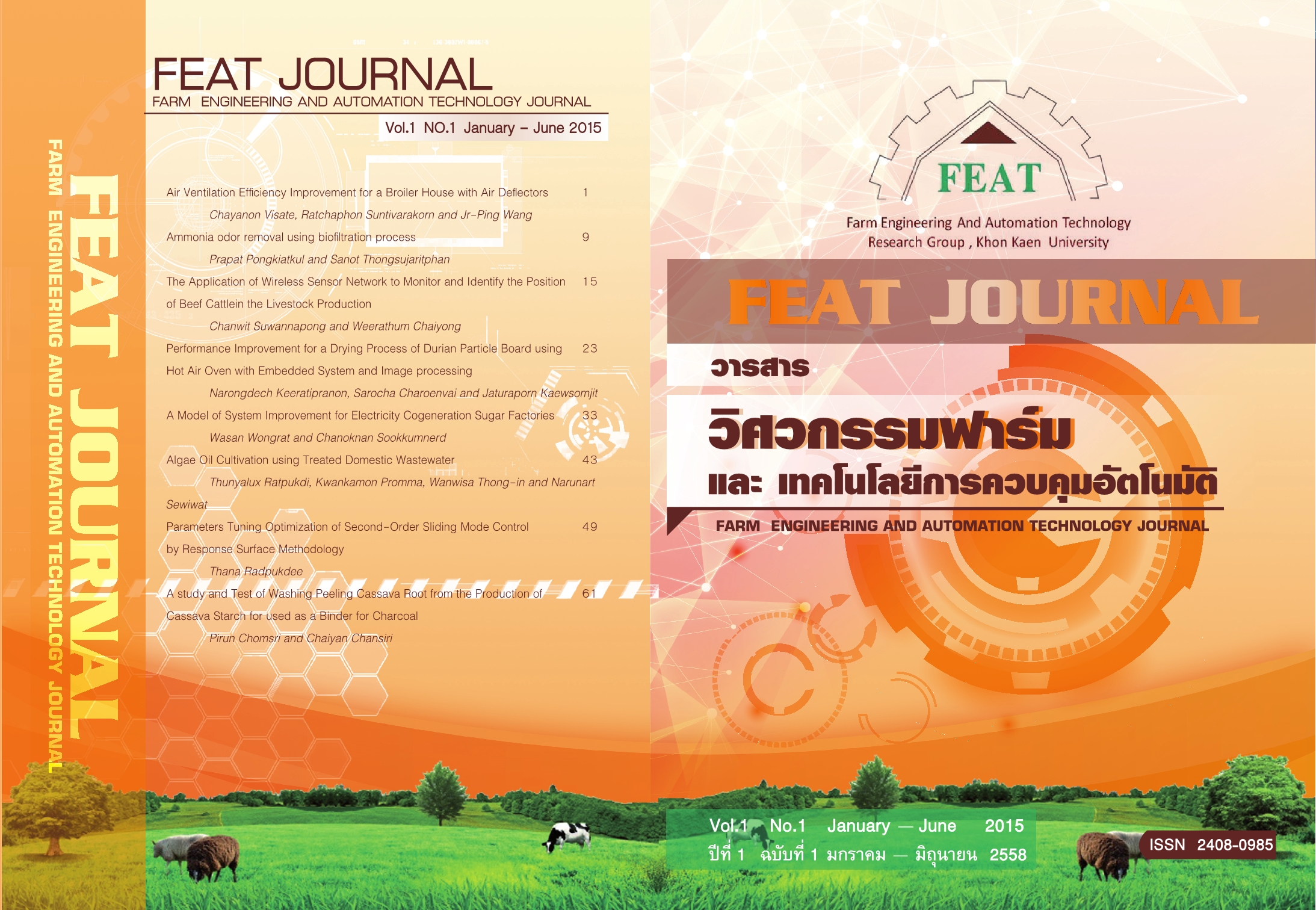Parameters tuning optimization of second-order sliding mode control by response surface methodology
Main Article Content
บทคัดย่อ
In this paper, tracking performance optimization of a second-order sliding mode control (SMC), namely twisting sliding mode is considered through optimal tuning of its control parameters. Effectiveness of transient response can be achieved by considering as minimization of maximum-overshoot ( ) and settling-time ( ), which are obtained through the Response Surface Methodology (RSM). For the optimal tracking performance with the RSM, the computation process by mean of a central composite design (CCD) is performed through a quadratic equation. Finding results of a simulation confirm that the optimal tracking performance as the minimization of the and can be achieved by the optimization tuning control parameters with the RSM.
Article Details
วารสารวิศวกรรมฟาร์มและเทคโนโลยีควบคุมอัตโนมัติ (FEAT Journal) มีกําหนดออกเป็นราย 6 เดือน คือ มกราคม - มิถุนายน และ กรกฎาคม - ธันวาคม ของทุกปี จัดพิมพ์โดยกลุ่มวิจัยวิศวกรรมฟาร์มและเทคโนโลยีควบคุมอัตโนมัติ คณะวิศวกรรมศาสตร์มหาวิทยาลัยขอนแก่น เพื่อเป็นการส่งเสริมและเผยแพร่ความรู้ ผลงานทางวิชาการ งานวิจัยทางด้านวิศวกรรมศาสตร์และเทคโนโลยีพร้อมทั้งยังจัดส่ง เผยแพร่ตามสถาบันการศึกษาต่างๆ ในประเทศด้วย บทความที่ตีพิมพ์ลงในวารสาร FEAT ทุกบทความนั้นจะต้องผ่านความเห็นชอบจากผู้ทรงคุณวุฒิในสาขาที่เกี่ยวข้องและสงวนสิทธิ์ ตาม พ.ร.บ. ลิขสิทธิ์ พ.ศ. 2535
เอกสารอ้างอิง
[2] Utkin, V.I., Sliding mode control design principles and applications to electric drives. Industrial Electronics, IEEE Transactions on, 1993. 40(1): p. 23-36.
[3] Bartolini, G., A. Ferrara, and E. Usani, Chattering avoidance by second-order sliding mode control. Automatic Control, IEEE Transactions on, 1998. 43(2): p. 241-246.
[4] Bartolini, G., et al., A survey of applications of second-order sliding mode control to mechanical systems. International Journal of Control, 2003. 76(9-10): p. 875-892.
[5] Bartolini, G., E. Punta, and T. Zolezzi, Approximability Properties for Second-Order Sliding Mode Control Systems. Automatic Control, IEEE Transactions on, 2007. 52(10): p. 1813-1825.
[6] Boiko, I., et al., Analysis of Chattering in Systems With Second-Order Sliding Modes. Automatic Control, IEEE Transactions on, 2007. 52(11): p. 2085-2102.
[7] Levant, A., Principles of 2-sliding mode design. Automatica, 2007. 43(4): p. 576-586.
[8] Taleb, M., A. Levant, and F. Plestan, Pneumatic actuator control: Solution based on adaptive twisting and experimentation. Control Engineering Practice, 2013. 21(5): p. 727-736.
[9] Polyakov, A. and A. Poznyak, Lyapunov function design for finite-time convergence analysis: “Twisting” controller for second-order sliding mode realization. Automatica, 2009. 45(2): p. 444-448.
[10] Reichhartinger, M. and M. Horn, Application of Higher Order Sliding-Mode Concepts to a Throttle Actuator for Gasoline Engines. Industrial Electronics, IEEE Transactions on, 2009. 56(9): p. 3322-3329.
[11] Dongcheol, K. and R. Sehun, Design of an optimal fuzzy logic controller using response surface methodology. Fuzzy Systems, IEEE Transactions on, 2001. 9(3): p. 404-412.
[12] Grefenstette, J.J., Optimization of Control Parameters for Genetic Algorithms. Systems, Man and Cybernetics, IEEE Transactions on, 1986. 16(1): p. 122-128.
[13] Dai, C., et al., Seeker optimization algorithm for tuning the structure and parameters of neural networks. Neurocomputing, 2011. 74(6): p. 876-883.
[14] Chu, C.-W., B. Erik Ydstie, and N.V. Sahinidis, Optimization of IMC-PID Tuning Parameters for Adaptive Control: Part 1, in Computer Aided Chemical Engineering,
M.C.G. E.N. Pistikopoulos and A.C. Kokossis, Editors. 2011, Elsevier. p. 758-762.
[15] Kao, C.-C., C.-W. Chuang, and R.-F. Fung, The self-tuning PID control in a slider–crank mechanism system by applying particle swarm optimization approach. Mechatronics, 2006. 16(8): p. 513-522.
[16] Demirtas, M. and A.D. Karaoglan, Optimization of PI parameters for DSP- based permanent magnet brushless motor drive using response surface methodology. Energy Conversion and Management, 2012. 56(0): p. 104-111.
[17] Sahraian, M. and S. Kodiyalam, TUNING PID CONTROLLERS USING ERROR-INTEGRAL CRITERIA AND RESPONSE SURFACES BASED OPTIMIZATION. Engineering Optimization, 2000. 33(2): p. 135-152.
[18] Iskender, B., N. Özdemir, and A. Karaoglan, Parameter Optimization of Fractional Order PI λ D μ Controller Using Response Surface Methodology, in Discontinuity and Complexity in Nonlinear Physical Systems, J.A.T. Machado, D. Baleanu, and A.C.J. Luo, Editors. 2014, Springer International Publishing. p. 91-105.
[19] Romero, J.A., R. Sanchis, and P. Balaguer, PI and PID auto-tuning procedure based on simplified single parameter optimization. Journal of Process Control, 2011. 21(6): p. 840-851.
[20] Eker, I., Second-order sliding mode control with experimental application. ISA Transactions, 2010. 49(3): p. 394-405.
[21] Eker,i., Second-Order Sliding Mode Control with PI Sliding Surface and Experimental Application to an Electromechanical Plant. Arabian Journal for Science and Engineering, 2012. 37(7): p. 1969-1986.
[22] Carbajal-Espinosa, O., et al., Robust Dynamic Control of an Arm of a Humanoid Using Super Twisting Algorithm and Conformal Geometric Algebra, in Computational Kinematics, F. Thomas and A. Perez Gracia, Editors. 2014, Springer Netherlands. p. 261-269.
[23] M. Taleb, A. Levant, and a.F. Plestan, Twisting algorithm adaptation for control of electropneumatic actuators, in 12 th IEEE Workshop on Variable Structure SystemsJanuary 2012, IEEE: Mumbai.
[24] Yildiz, Y., et al., Spark-Ignition-Engine Idle Speed Control: An Adaptive Control Approach. Control Systems Technology, IEEE Transactions on, 2011. 19(5): p. 990-1002.


